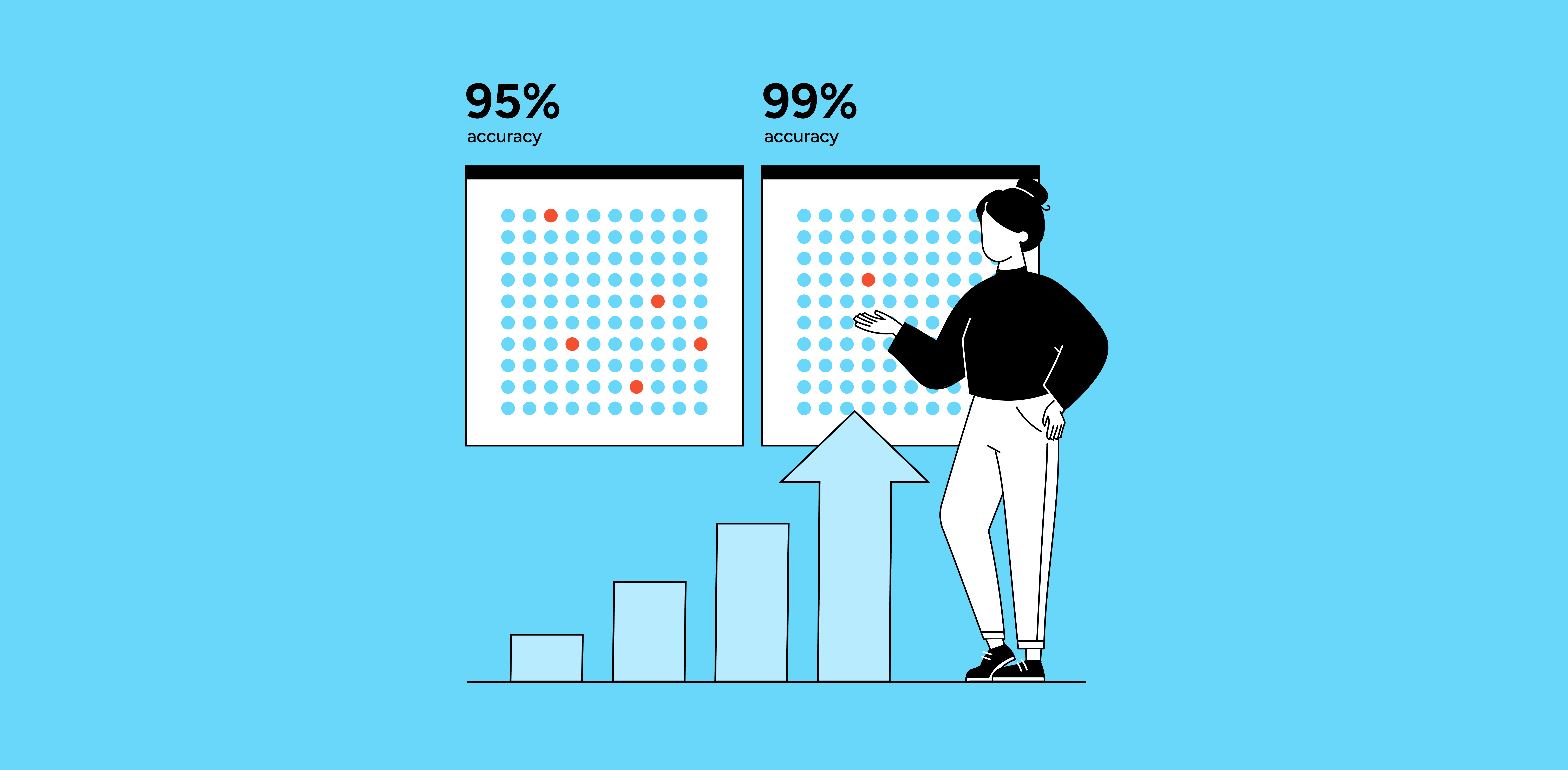The hidden impact of 'almost accurate' data in Digital Shelf Analytics.
When evaluating digital shelf analytics providers, most brands assume that 95% data accuracy is sufficient. After all, what's the practical difference between 95% and 99%? The answer reveals itself in the compound effect of those daily errors and their impact on decision-making, resource allocation, and competitive positioning.
In short: The difference between 95% and 99% data accuracy eliminates 146,000 annual data errors for brands managing 10,000 SKUs. According to Gartner, poor data quality costs organisations an average of $12.9 million annually. At eStore, we deliver 99%+ accuracy, consistently 4% higher than any competitor, enabling faster decisions, reduced verification overhead, and the confidence to act on insights without second-guessing.
How significant is the difference between 95% and 99% data accuracy?
The mathematics are straightforward but the implications are significant. For a brand managing 10,000 SKUs, 95% accuracy means 500 products have incorrect data every day. At 99% accuracy, this drops to just 100 products. Over a year, that's 146,000 fewer data incidents requiring attention, investigation, or correction.
But the impact extends beyond the immediate error count. When your digital shelf analytics are wrong 5% of the time, teams begin questioning all the data. This erosion of trust leads to extensive manual verification, delayed decision-making, and reluctance to act on insights, even when they're correct.

What are the real-world consequences of data inaccuracy?
Consider the practical implications across key digital shelf activities:
Stock monitoring accuracy: When your analytics incorrectly report product availability, teams either rush to address non-existent problems or miss actual stock-outs. Both scenarios waste resources and can damage retailer relationships. Our research on out-of-stock monitoring reveals brands discover 2.5x more availability issues with accurate location-based data.
Search optimisation decisions: Incorrect data about search rankings or keyword performance leads to misallocated effort. Teams might optimise for keywords that aren't actually underperforming or ignore genuine opportunities.
Competitive intelligence: Inaccurate competitor data affects strategic decisions about pricing, positioning, and promotional timing. Making strategic moves based on incorrect competitive insights can be costly.
Content and compliance: Errors in content scoring or missing listing detection mean teams either fix problems that don't exist or overlook genuine issues affecting conversion rates. With GPSR compliance requirements now carrying penalties of €100,000 per violation, accuracy is essential.
How does inaccurate data erode team trust?
Here's what makes the 4% difference particularly damaging: it's just frequent enough to create doubt but not obvious enough to immediately identify. Teams working with 95% accurate data develop checking habits that persist even when viewing accurate information.
This phenomenon compounds the inefficiency. Teams spend time verifying correct data, double-checking insights, and building workarounds for anticipated errors. The operational cost extends far beyond the specific incorrect data points.
What does poor data quality actually cost?
According to Gartner research, poor data quality costs organisations an average of $12.9 million annually. While this figure encompasses all data quality issues across an organisation, digital shelf analytics errors contribute directly through:
- Wasted team time on verification and correction
- Delayed or incorrect strategic decisions
- Misallocated marketing and promotional spend
- Missed opportunities during critical sales periods
- Damaged retailer relationships from incorrect reporting
What competitive advantages does superior accuracy create?
The 4% accuracy improvement creates several competitive advantages:
Faster decision-making: Teams trust the data and act quickly on insights without extensive verification processes.
Resource efficiency: Less time spent checking and correcting data means more time available for strategic work.
Proactive management: Accurate early warning systems enable brands to address issues before they impact sales.
Stronger retailer relationships: Consistently accurate reporting builds credibility with retail partners.
Better campaign performance: Marketing decisions based on accurate competitive and performance data deliver superior results.
How does eStore achieve 99%+ data accuracy?
At eStore, we deliver 99%+ data accuracy across our digital shelf analytics platform, consistently 4% higher than any competitor in the market (as of 2025). This isn't a marketing claim but a measurable technical achievement that directly impacts your operational efficiency and decision-making confidence.
While the industry standard hovers around 95%, our investment in data quality infrastructure, verification processes, and continuous monitoring ensures you receive the most accurate digital shelf insights available. This accuracy differential is the foundation that enables everything else, from trusted automated alerts to reliable competitive intelligence.
Beyond the immediate accuracy benefits, 99% accurate data enables more sophisticated platform capabilities including automated alerting teams can trust, AI-driven recommendations that perform better with cleaner input data, and predictive insights with significantly improved forecasting accuracy.
Key Takeaways
- 📊 For brands managing 10,000 SKUs, 99% accuracy eliminates 146,000 annual data errors compared to 95% accuracy
- 💰 Gartner research shows poor data quality costs organisations an average of $12.9 million annually
- 🤖 eStore delivers 99%+ accuracy, consistently 4% higher than any competitor in the market
- ⏱️ Teams with accurate data act on insights immediately rather than spending time on verification
- 🔍 The trust erosion effect means even correct data gets questioned when accuracy is inconsistent
- 💡 Superior accuracy enables proactive management, catching issues before they impact sales
Frequently Asked Questions
What is the practical difference between 95% and 99% data accuracy?
For a brand managing 10,000 SKUs, 95% accuracy means 500 products have incorrect data every day, while 99% accuracy reduces this to just 100 products. Over a year, that's 146,000 fewer data incidents requiring attention, investigation, or correction.
How does inaccurate data affect team productivity?
When data accuracy sits at 95%, teams develop verification habits that persist even when viewing correct information. They spend significant time double-checking insights, building workarounds, and delaying decisions. This operational overhead compounds well beyond the specific incorrect data points.
What is the financial impact of poor data quality?
According to Gartner research, poor data quality costs organisations an average of $12.9 million annually. For digital shelf analytics specifically, this manifests through wasted verification time, delayed strategic decisions, misallocated promotional spend, and missed opportunities during critical sales periods.
How does eStore achieve higher accuracy than competitors?
eStore delivers 99%+ data accuracy through investment in data quality infrastructure, multi-layer verification processes, and continuous monitoring systems. This technical achievement is measurable and consistent, not a marketing claim. The 4% accuracy advantage over competitors is verified through ongoing benchmarking.
Why does 4% extra accuracy matter for automated alerts?
At 95% accuracy, teams cannot fully trust automated alerts and must manually verify each one before acting. At 99%+ accuracy, teams trust alerts and respond immediately, enabling genuinely proactive digital shelf management rather than reactive firefighting.
How does data accuracy affect AI and predictive analytics?
Machine learning algorithms and predictive models perform significantly better with cleaner input data. The 4% accuracy improvement enables more reliable trend analysis, better forecasting, and more accurate AI-driven recommendations across the platform.
Related Articles
- What Is Digital Shelf Analytics?
- Why Digital Shelf Content Compliance Matters in 2025
- Out of Stock Monitoring: Why Location Data Matters
References and Further Reading
Industry Research
- Gartner: How to Improve Your Data Quality
eStore Resources




